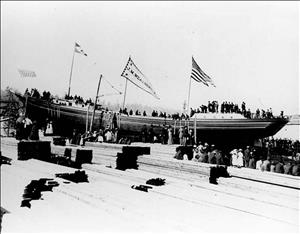On May 12, 1890, Aberdeen, located at the confluence of the Wishkah and Chehalis rivers on Grays Harbor, incorporates. Founded by Samuel (1832-1935) and Martha (1845-1917) Benn, the town sits on an advantageous site on one of the few harbors along the Washington coast large and deep enough to accommodate ocean-going vessels. The land surrounding the town holds some of the richest timberlands in the world and the waters teem with fish and shellfish. Aberdeen has grown up around canneries and lumber mills and become a commercial center for loggers who come into town between jobs in the woods.The town will have decades of lumber- and fisheries-based prosperity until the resources become scarce. During the latter half of the twentieth century the town will have to adjust its economy, with tourism and retail sales taking the place of lumber and fish.
Early Aberdeen Days
Early settlers near the mouth of the Wishkah River lived on subsistence farms among the Lower Chehalis Indians, who had villages where Westport is today and along the rivers and sloughs of the river valley. The area remained isolated from markets because it lacked roads to the interior and steamship service up the rivers was sporadic. Most travel was done by canoe along the rivers. In 1862 Reuben Redman (1820-1917) settled at the mouth of the Wishkah and established a farm there.
Several years earlier, in 1859, Samuel Benn had settled at Melbourne, on the Chehalis River. He had arrived from New York via California and British Columbia, having tried both the California and Fraser River gold rushes. Not long after the Redmans arrived, Benn married Martha Redman (1846-1917), Reuben’s daughter. They lived for several years at Melbourne, but then, in 1868, traded property with Reuben Redman, seeing the potential of the farm’s land as a town site.
The Benns purchased several other tracts of land and farmed alongside the scattered farms in the vicinity. Though Samuel Benn envisioned a town on the site, growth was limited by several factors. First, the bay was big enough for many ocean-going vessels, but not consistently deep like the bays on Puget Sound. Further, the entrance to the harbor had not been deepened and its relatively shallow depth limited its accessibility. Second, the only routes inland relied on the river or trails through the forest. No roads or railroad connected the settlement to Olympia or other market towns. Finally, the few mills that did exist on the bay had a small output that was mostly used by local residents to build houses and outbuildings. They did not have the capacity to produce enough lumber to attract more ships.
Building a Town
The Benns decided to offer land to anyone willing to establish a business on the Wishkah. In 1876 the first cannery in what is now Aberdeen was built by George Hume. In 1884 A. J. West, a lumberman from Michigan, moved to Grays Harbor and built a mill on the Benns’ land. Not long after, J. M. Weatherwax, also from Michigan, joined them and built another mill. By 1886 the first load of lumber for outside markets was shipped. The Benns would eventually give away or sell, often for payments designed to make lots more affordable for families, two-thirds of their land.
These mills, along with a general store, a saloon, and a hotel formed the nucleus of the new town emerging on the Benn land. Over the next five years the town grew from fewer than 50 residents to more than 1,600. More mills grew up, some for lumber, others for shingles. Between 1889 and 1890, the town saw a spurt of growth, a state census in 1889 counted 853 residents in Aberdeen. By the following year the federal census counted 1,638. The same jump was seen in the public schools, where enrollment increased from 109 in the fall of 1889 to 204 in the spring of 1890. It appears that much of the town’s growth was due to families moving into town.
In 1890 the town had four sawmills, a flour mill, two sash and door factories, a shipyard, three salmon canneries, two banks, and a newspaper. It had become the manufacturing and commercial center on Grays Harbor.
Incorporating and Governing
The town had been named and platted in 1884 but not incorporated. After the tremendous growth in the 1880s, it was time to incorporate. On May 12, 1890, Aberdeen became a city, with local real-estate agent, J. B. Maling, serving as mayor. C. T. Wooding, a banker, served as the first treasurer. Six men served on the first council: William Anstie, Alex Young, E. L. Kochler, O. M. Kellogg, J. A. West, and L. F. Babcock.
In the coming decade the town would continue to develop its infrastructure, building bridges across the rivers and a railroad spur to connect with the Northern Pacific Railroad. Mills would increase in number and capacity. Lumbering and related industries would continue to fuel growth in Aberdeen until the 1930s. After the Depression, the long, slow transition away from an economy based on natural resources began, and continues today.

